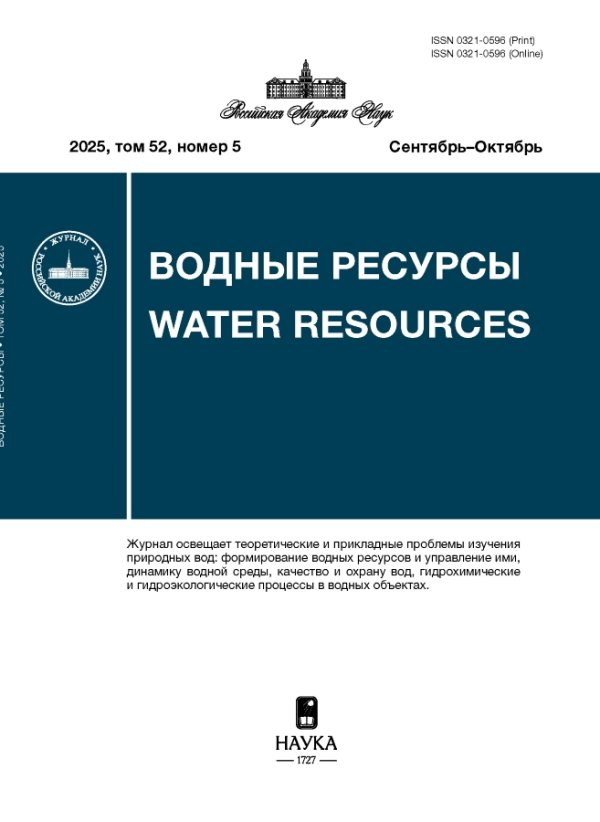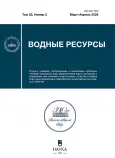The factors of suspended sediment concentration increasing in the Lena River delta
- Authors: Prokopeva K.N.1, Chalov S.R.2
-
Affiliations:
- Water Problems Institute of the Russian Academy of Science
- Lomonosov Moscow State University
- Issue: Vol 52, No 2 (2025)
- Pages: 30-44
- Section: ВОДНЫЕ РЕСУРСЫ И РЕЖИМ ВОДНЫХ ОБЪЕКТОВ
- URL: https://journal-vniispk.ru/0321-0596/article/view/295047
- DOI: https://doi.org/10.31857/S0321059625020037
- EDN: https://elibrary.ru/UCSZQW
- ID: 295047
Cite item
Abstract
This paper presents an analysis of the factors contributing to the longitudinal increase in suspended sediment along the Lena River delta branches. Satellite images (Landsat 5-9) from 2000 to 2022 during the open channel period from June to September were captured for the suspended sediment concentration modeling. This period coincides with the water discharge in the Lena River ranging from 17,400 to 78,100 m³/s. The ERA5-Land reanalysis, monitoring observations at the Samoilovsky Island research station and remote sensing data were employed to estimate the factors influencing suspended sediment concentration changes. These factors included air temperature, precipitation, wind speed, solar radiation flux, permafrost temperature, water discharge and suspended sediment concentration in the top of the delta top, and the intensity of bank retreat. The results of the correlation analysis indicated that the observed increase in suspended sediment concentration was attributable to a combination of meteorological factors (temperature, precipitation, wind speed, and solar radiation flux) and the intensity of riverbank erosion associated with thermal processes. The longitudinal increase in in suspended sediment concentration (on average for the study period by 2-4% along the delta length) can be explained by an average daily air temperature and permafrost temperature increase. The analysis demonstrated that temperature factors exert a predominant influence on riverbanks comprising the Ice Complex. here was a significant correlation between the rates of riverbank degradation and the concentration of suspended sediment.
About the authors
K. N. Prokopeva
Water Problems Institute of the Russian Academy of Science
Author for correspondence.
Email: prokris3@mail.ru
Russian Federation, Moscow, 119333
S. R. Chalov
Lomonosov Moscow State University
Email: hydroserg@mail.ru
Russian Federation, Moscow, 119234
References
- Большиянов Д.Ю., Макаров А.С., Шнайдер В., Штоф Г. Происхождение и развитие дельты реки Лены. СПб.: ААНИИ, 2013. 268 с.
- Гуков А.Ю. Гидробиология устьевой области реки Лены. М.: Науч. мир, 2001. 288 с.
- Иванов В.А., Чалов С.Р. Эмпирическая модель распределения взвешенных наносов по глубине крупных рек // Гидросфера. Опасные процессы и явления. 2022. Т. 4. № 2. С. 149–164.
- Иванов В.В., Пискун А.А., Корабель Р.А. Распределение стока по основным рукавам дельты Лены // Тр. ААНИИ. 1983. С. 59–71.
- Конищев В.Н. Реакция вечной мерзлоты на потепление климата // Вестн. Московского ун-та. Сер. 5, География. 2009. № 4. С. 10–20.
- Коротаев В.Н., Михайлов В.Н., Бабич Д.Б., Богомолов А.Л., Заец Г.М. Гидролого-морфолгические процессы в дельте р. Лены // Земельные и водные ресурсы. Противоэрозионная защита и реглирование русел. М.: Изд-во Московского ун-та, 1990. С. 120–144.
- Лопатин Г.В., Федоров М.К. Физико-географический очерк дельты р. Лены. АНИИ. Л.: АННИ, 1947. 320 с.
- Магрицкий Д.В., Айбулатов Д.Н., Горелкин А.В. Закономерности пространственно-временной изменчивости стока на предустьевом участке и в дельте р.Лены // Вод. ресурсы. 2018. Т. 45. № 1. С. 15–29. doi: 10.7868/S0321059618010133
- Магрицкий Д.В., Чалов С.Р., Гармаев Е.Ж., Прокопьева К.Н., Крастынь Е.А. Новые данные о трансформации стока воды и наносов в дельте реки Лены по итогам экспедиционных измерений в августе 2022 г. // Проблемы Арктики и Анарктики. 2023. Т. 69. № 2. С. 171–190. doi: 10.30758/0555-2648-2023-69-2-171-190
- Тасаков П.Д. Сток взвешенных наносов в устье р. Лены // Тр. ГГИ. 1965. № 125. С. 125–138.
- Федорова И.В., Большиянов Д.Ю., Макаров А.С., Третьяков М.В., Четверова А.А. Современное гидрологическое состояние дельты р. Лены // Система моря Лаптевых и прилегающих морей Арктики: современное состояние и история развития. М.: Изд-во МГУ, 2009. С. 278–291.
- Федорова И.В., Четверова А.А., Алексеева Н.К., Скороспехова Т.В., Романов С.Г., Большиянов Д.Ю., Шадрина А.А., Макушин М.А. Гидрологические и гидрохимические исследования в дельте р. Лены весной 2015 и 2016 гг. // Проблемы Арктики и Анарктики. 2017. № 3 (113). С. 107–114.
- Чаркин А.Н., Федорова И.В., Семилетов И.П., Четверова А.А., Густаффсон О. Масштабы пространственной изменчивости распределения взвеси в системе “Река Лена – Море Лаптевых” // Геология, география и экология океана. Ростов-на-Дону: ЮНЦ, 2009. С. 351–354.
- Alabyan A.M., Chalov R.S., Korotaev V.N., Sidorchuk A.Y., Zaitsev A.A. Natural and technogenic water and sediment supply to the Laptev Sea // Berichte zur Polarforschung (Reports on Polar Research). 1995. № 182. P. 264–271.
- Boike J., Nitzbon J., Anders K., Grigoriev M., Bolshiyanov D., Langer M., Lange S., Bornemann N., Morgenstern A., Schreiber P., Wille C., Chadburn S., Gouttevin I., Burke E., Kutzbach L. A 16-year record (2002–2017) of permafrost, active-layer, and meteorological conditions at the Samoylov Island Arctic permafrost research site, Lena River delta, northern Siberia: an opportunity to validate remote-sensing data and land surface, snow, and // Earth Syst. Sci. Data. 2019. V. 11. P. 261–299. DOI: doi.org/10.5194/essd-11-261-2019
- Chalov S., Prokopeva K. Sedimentation and Erosion Patterns of the Lena River Anabranching Channel // Water. 2022. V. 14. № 23. P. 3845. doi: 10.3390/w14233845
- Chalov S., Prokopeva K., Habel M. North to South Variations in the Suspended Sediment Transport Budget within Large Siberian River Deltas Revealed by Remote Sensing Data // Remote Sensing. 2021. V. 13. № 22. P. 4549. doi: 10.3390/rs13224549
- Chalov S., Prokopeva K., Magritsky D., Grigoriev V., Fingert E., Habel M., Juhls B., Morgenstern A., Overduin P.P., Kasimov N. Climate change impacts on streamflow, sediment load and carbon fluxes in the Lena River delta // Ecol. Indicators. 2023. V. 157. P. 111252. doi: 10.1016/j.ecolind.2023.111252
- Chalov S.R., Moreido V.M., Prokopeva K.N., Efimov V.A. Implications of yedoma bank outcrops on the arctic rivers sediment runoff // Hydrosphere. Hazard processes and phenomena. 2022. V. 4. P. 165–182 (In Russian; abstract in English). doi: 10.34753/HS.2022.4.2.165
- Chalov S.R., Prokopeva K.N. Assessment suspended sediment budget of the Lena River delta based on the remote sensing dataset // Issledovanie Zemli iz kosmosa. 2021. № 3. P. 19–29.
- Ogneva O., Mollenhauer G., Juhls B., Sanders T., Palmtag J., Fuchs M., Grotheer H., Mann P.J., Strauss J. Particulate organic matter in the Lena River and its Delta: From the permafrost catchment to the Arctic Ocean // Biogeosci. 2022. V. 20. № 7. P. 1423–1441. doi: 10.5194/bg-20-1423-2023
- Rachold V., Alabyan A.M., Hubberten H.W., Korotaev V.N., Zaitsev A.A. Sediment transport to the Laptev Sea – Hydrology and geochemistry of the Lena River // Polar Res. 1996. V. 15. № 2. P. 183–196. doi: 10.3402/polar.v15i2.6646
- Schwamborn G., Rachold V., Grigoriev M.N. Late Quaternary sedimentation history of the Lena Delta // Quaternary Int. 2002. doi: 10.1016/S1040-6182(01)00084-2
Supplementary files










